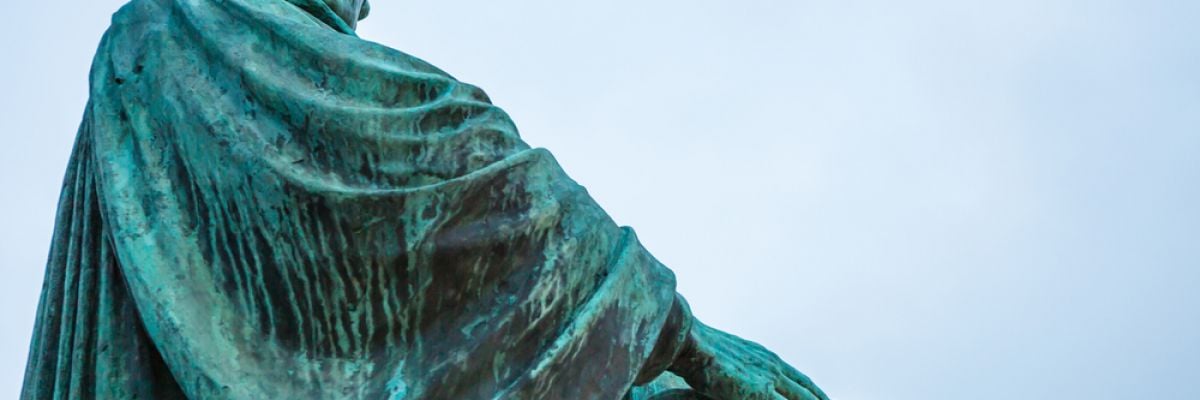
THE MYTH: Martin Luther was a simple reformer who desired to rid the Church of corruption and abuses, but when he challenged the pope on the issue of indulgences he was unjustly condemned, which forced him to break from the Church.
THE REAL STORY: This narrative is false. Luther was an unrepentant heretic whose teachings caused irreparable harm to the Catholic Church and Western civilization. When Pope Leo X (r. 1513-1521) recognized the danger of Luther’s teachings he strenuously and patiently urged his repentance.
Giovanni de’ Medici came from one of the most powerful families in Italy. His father, Lorenzo the Magnificent, was a diplomat, politician, patron of several great Renaissance artists including Michelangelo, and ruler of the Florentine Republic. From an early age, Giovanni was molded for a life in the Church. He was created a cardinal by Pope Innocent VIII at the age of thirteen but did not officially assume the functions of the office until he turned sixteen.
In 1513, the College of Cardinals sat in conclave to elect the successor of Pope Julius II. The cardinals were divided between a candidate favored by an older faction and Giovanni, now thirty-seven, who was favored by the younger faction. Eventually, Giovanni was elected and took the name Leo. Considered the last of the Renaissance popes, Leo X focused on political affairs throughout his pontificate but did not ignore the reform movement initiated by his predecessor. He oversaw the completion of the Fifth Lateran Council, which issued several reform decrees in response to ecclesiastical abuses rampant at the time. Leo is perhaps best known for his 1515 decision to continue the practice of granting an indulgence to those who contributed alms to a construction project he inherited that needed more funding: the building of the St. Peter’s Basilica in Rome, which gradually replaced the older and outdated version, which was much smaller and thus could not accommodate a large number of pilgrims at one time. Indulgence preachers were sent to regions throughout Christendom, including Electoral Saxony, home of an Augustinian monk named Martin Luther.
Luther took issue with the practice of granting indulgences and with certain Church teachings, and in 1517 published his opinions and complaints in his infamous 95 Theses. He also sent a copy to Archbishop Albert of Mainz, who forwarded the document to Rome, which is when Leo first heard about the monk who was to cleave Christendom. At first Leo believed the issue to be a quarrel between the Augustinian and Dominican religious orders (most indulgence preachers were Dominicans), so he ordered Luther’s superior to “soothe and quiet” the man. But Luther continued to advocate his heretical opinions by publishing several works in the spring of 1518.
Although Luther’s 95 Theses contained multiple heretical opinions, the most dangerous was his rejection of papal authority. Luther asserted the pope had no authority to dispense the merits of the treasury of grace to the faithful in the form of indulgences in order to remit the temporal punishment due to sin already forgiven in the sacrament of confession. This was not simply a sharp rebuke of an ecclesiastical abuse—Luther’s writings were an attack on the office of the papacy and of papal authority given by Christ in Matthew 16:18-19. In his Sermon on Indulgences and Grace Luther declared he did not believe indulgences had any benefit for the souls in purgatory, and in his Explanations of the Disputations on the Power of Indulgences he denied papal power extended to souls in purgatory. Luther’s attack on papal authority paved the way for his later demolition of the entire sacramental system and call for a national German church separated from Rome. Luther’s teachings were not reforms intended to return the Church to its pristine state but rather a rebellion designed to destroy the Church and create a new entity in Luther’s image.
These writings were studied in Rome, and in July 1518 a formal charge of “suspicion of disseminating heresy” was lodged against Luther. He was ordered to come to Rome to answer the charge within sixty days. Luther refused to leave Germany, claiming ill health and a fear for his safety. Although Leo could have enacted sterner measures against the recalcitrant monk, he chose the path of mercy and sent a personal envoy to meet with Luther and bring about his reconciliation.
Thomas de Vio (known as Cajetan) was a proponent of Church reform and a Dominican, who had been master general of the order for a decade. Cajetan traveled to Germany, believing he could convince Luther to cease his heretical teaching. When the two men met in October 1518, Cajetan approached Luther in a friendly and fatherly manner but Luther was obstinate in his denial of Church teaching and shifty in his answers. Unfortunately, his patience worn thin, Cajetan lost his temper and yelled at Luther, who responded in kind. At the urging of his superior, Luther later apologized to Cajetan for his outburst, but he held the Dominican in contempt, writing later, “He sought to turn me aside from the Christian faith, I doubt whether he is a Catholic Christian” (The Revolt of Martin Luther).
Leo promulgated a bull on indulgences a month later in which he reiterated Church teaching, so that Luther and others could not feign ignorance. Despite this papal document Luther continued to preach against Church teaching.
Given Luther’s recalcitrance, on June 15, 1520 Leo issued the bull Exsurge Domine. In it Leo urged the Lord to arise and vindicate the cause of the Church against the heresies emanating from Germany. The document listed forty-one teachings contained in the works of Luther that were “either heretical, scandalous, false, offensive to pious ears or seductive of simple minds, and against Catholic truth.” Leo bemoaned the fact that Luther did not respond to repeated attempts at reconciliation, including the request to come to Rome in person to discuss his teachings. He expressed regret at the situation but recognized his duty to safeguard the faithful from heresy. Leo included one more exhortation to Luther to recant, giving him sixty days to do so or else incur excommunication.
Luther responded by publishing a treatise entitled Against the Execrable Bull of Antichrist. He called Leo the Antichrist and wrote the purpose of the papal bull was to “compel men to deny God and worship the devil” (The Cleaving of Christendom: A History of Christendom). Later in the year Luther staged a public burning of Exsurge Domine and told his followers that whoever “does not resist the papacy with all his heart cannot obtain eternal salvation” (Saints and Sinners: A History of the Popes).
SUMMARY: The real story of Luther and the pope illustrates the patience and mercy exhibited by the Church at the beginning of the Protestant Reformation. The Church was not a corrupted institution resistant to reform and Luther was not a simple reformer. He was an obstinate heretic whom Leo urged repeatedly to repent. Unfortunately, Luther refused to listen.



